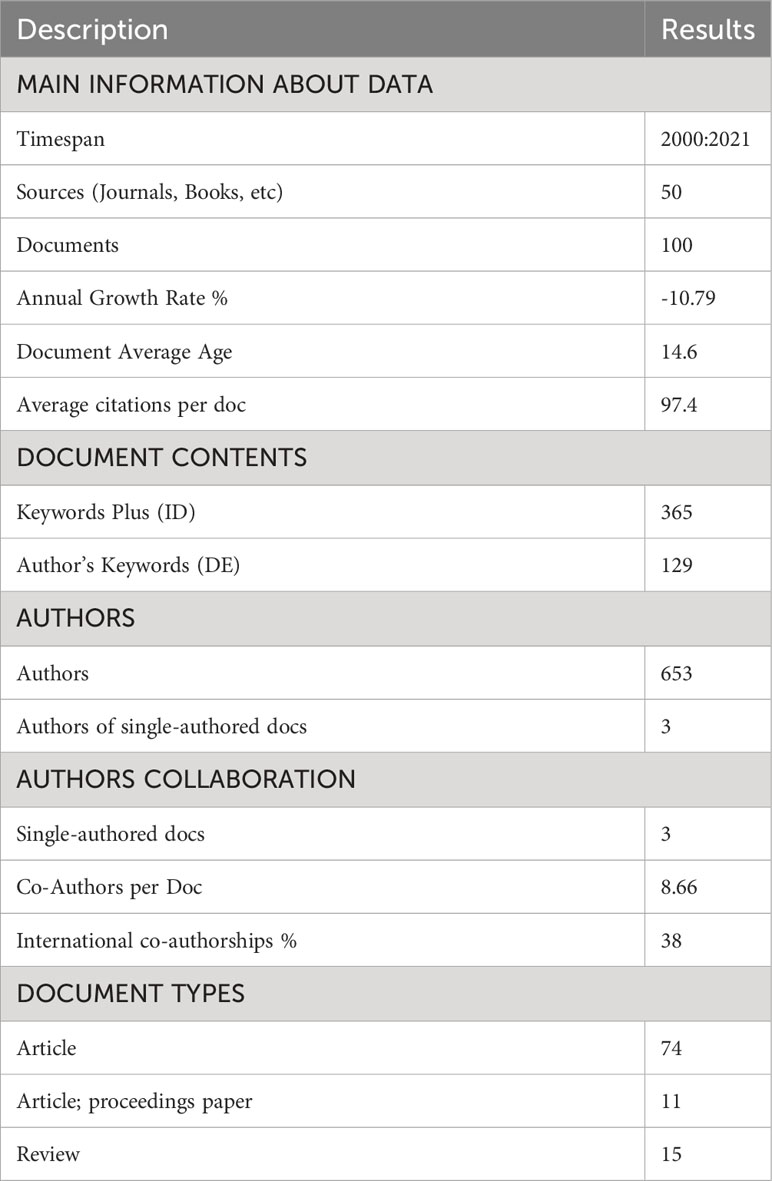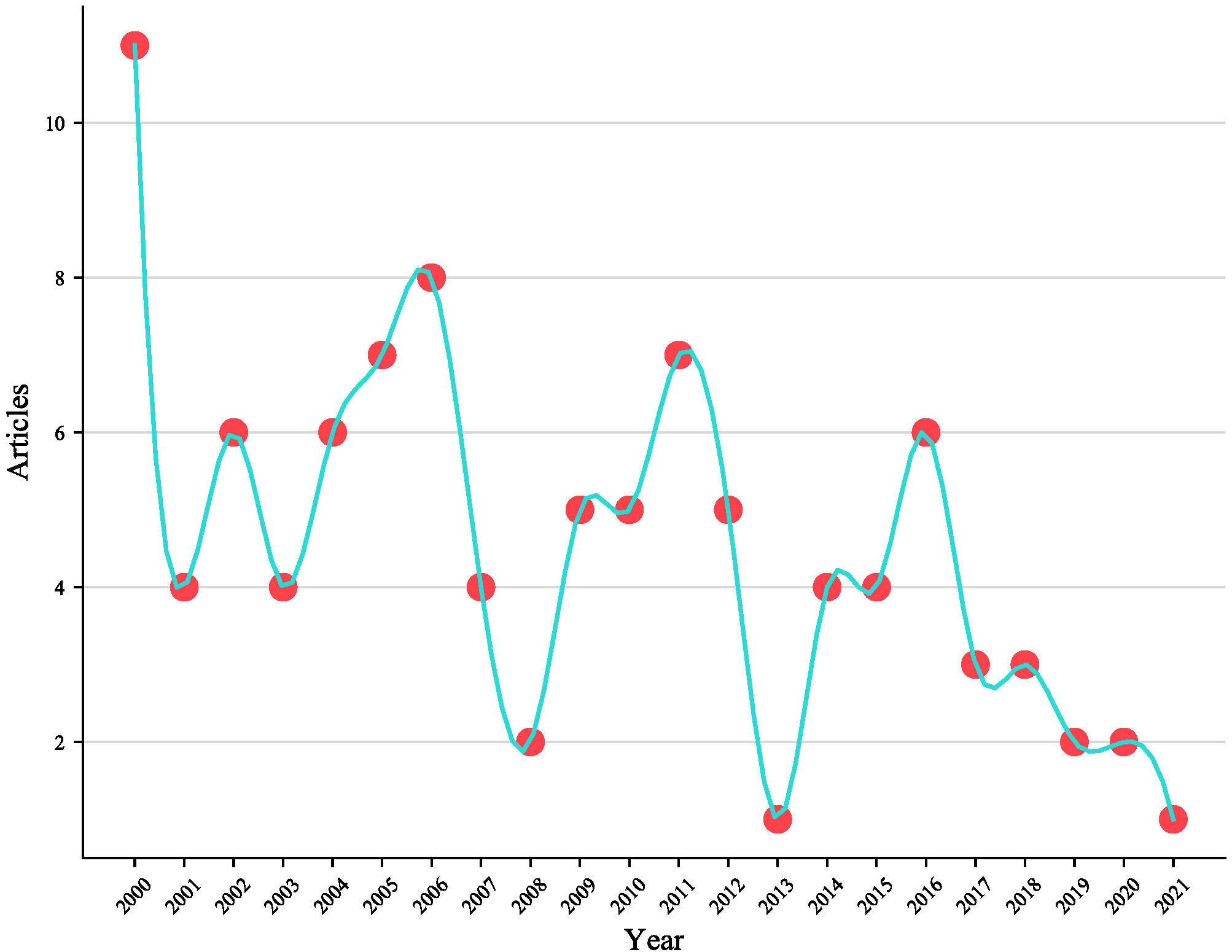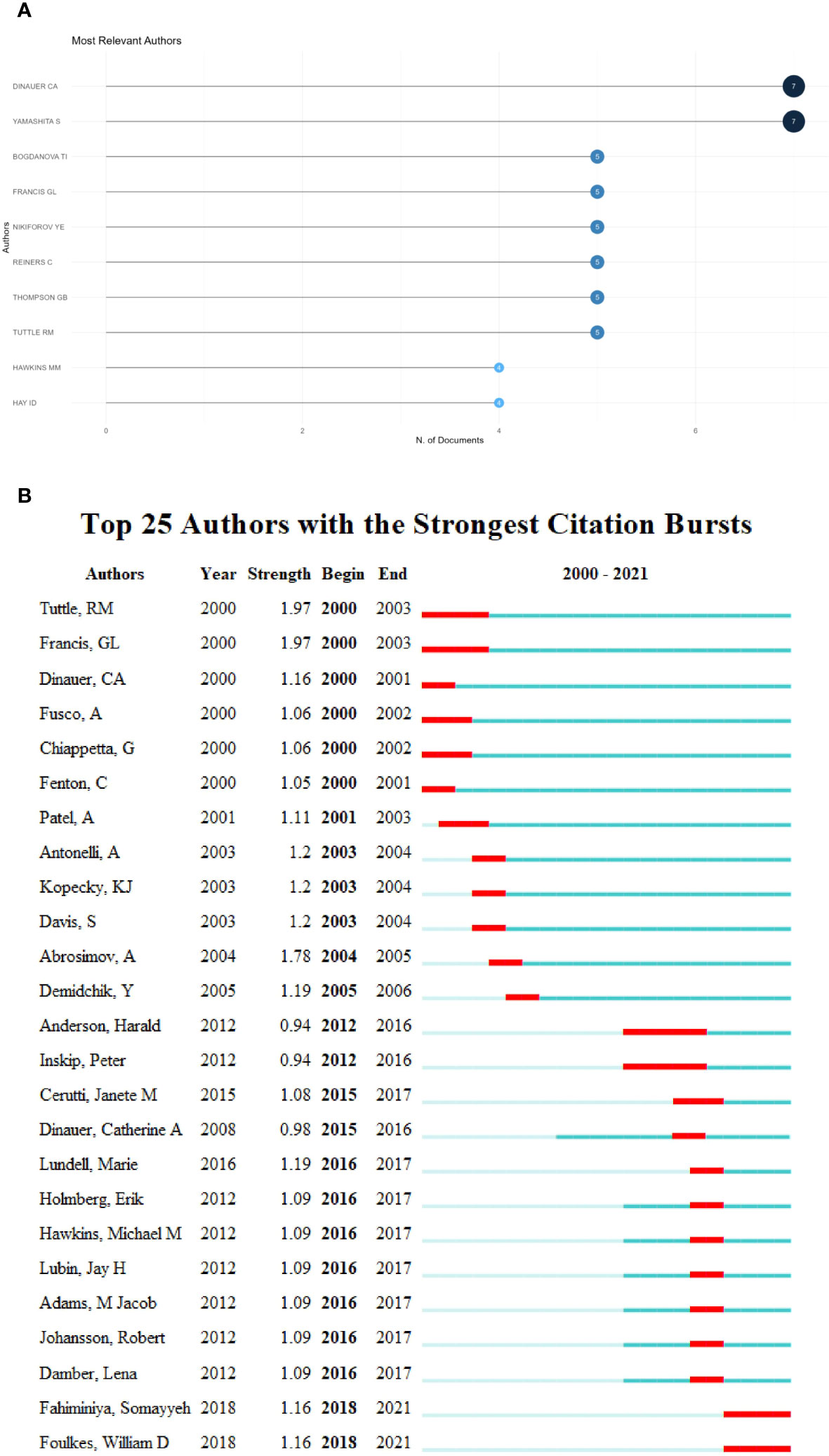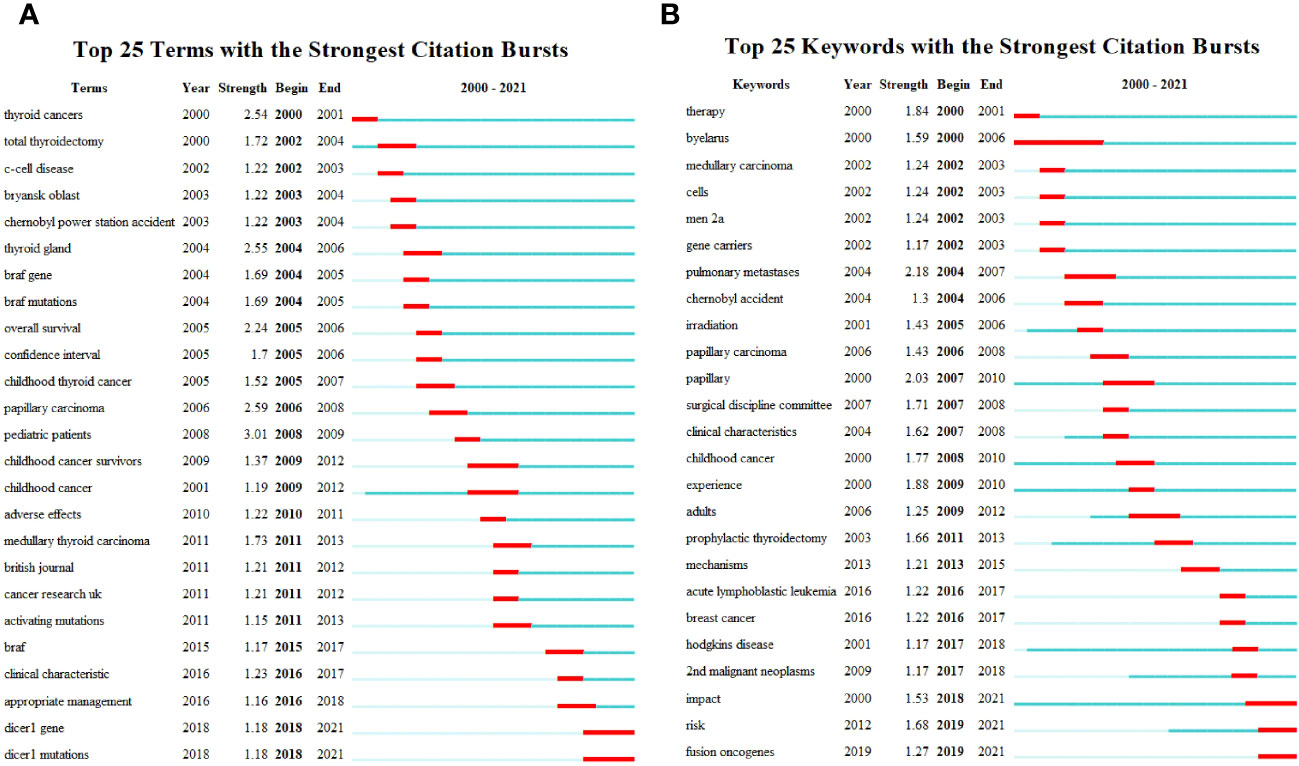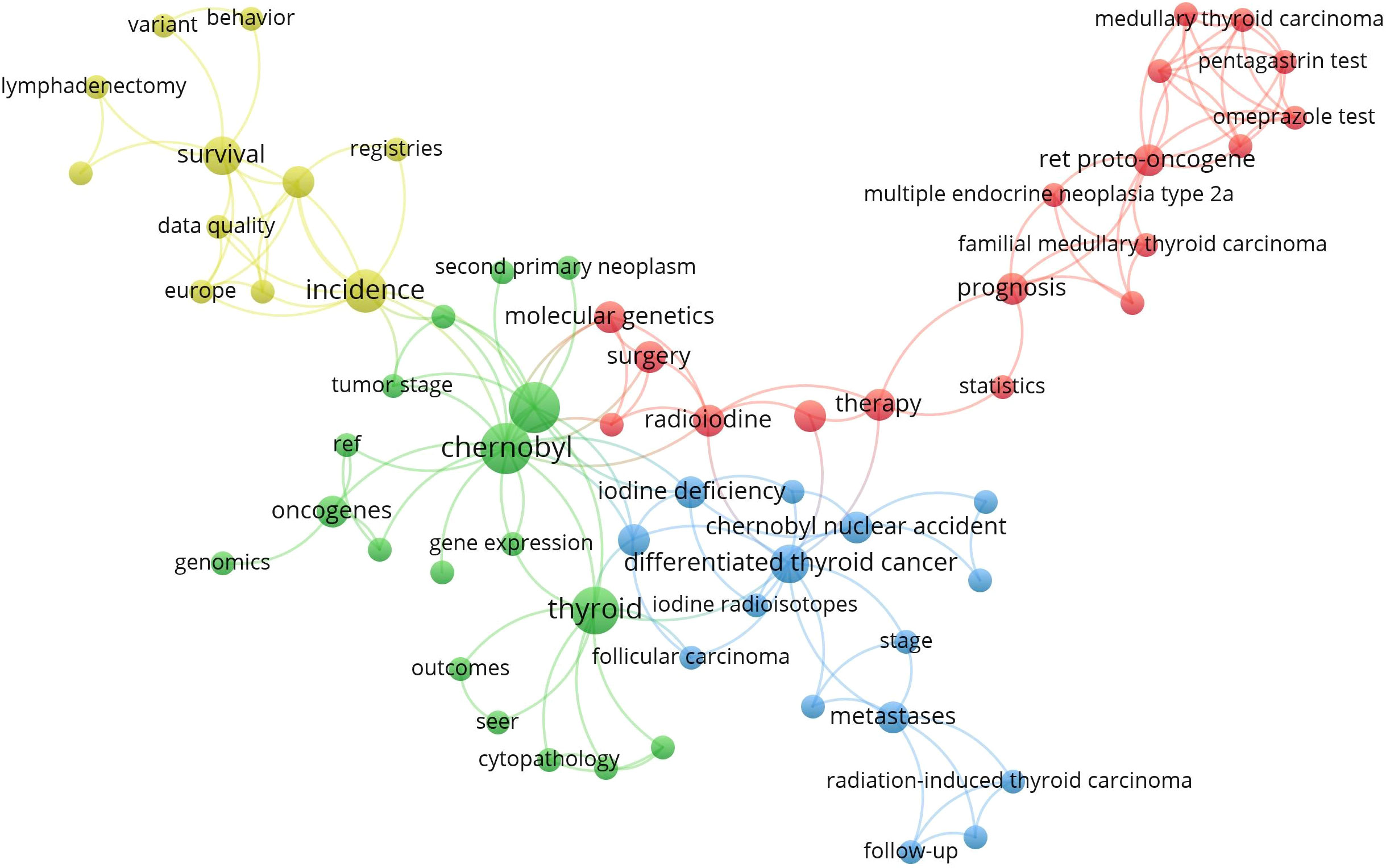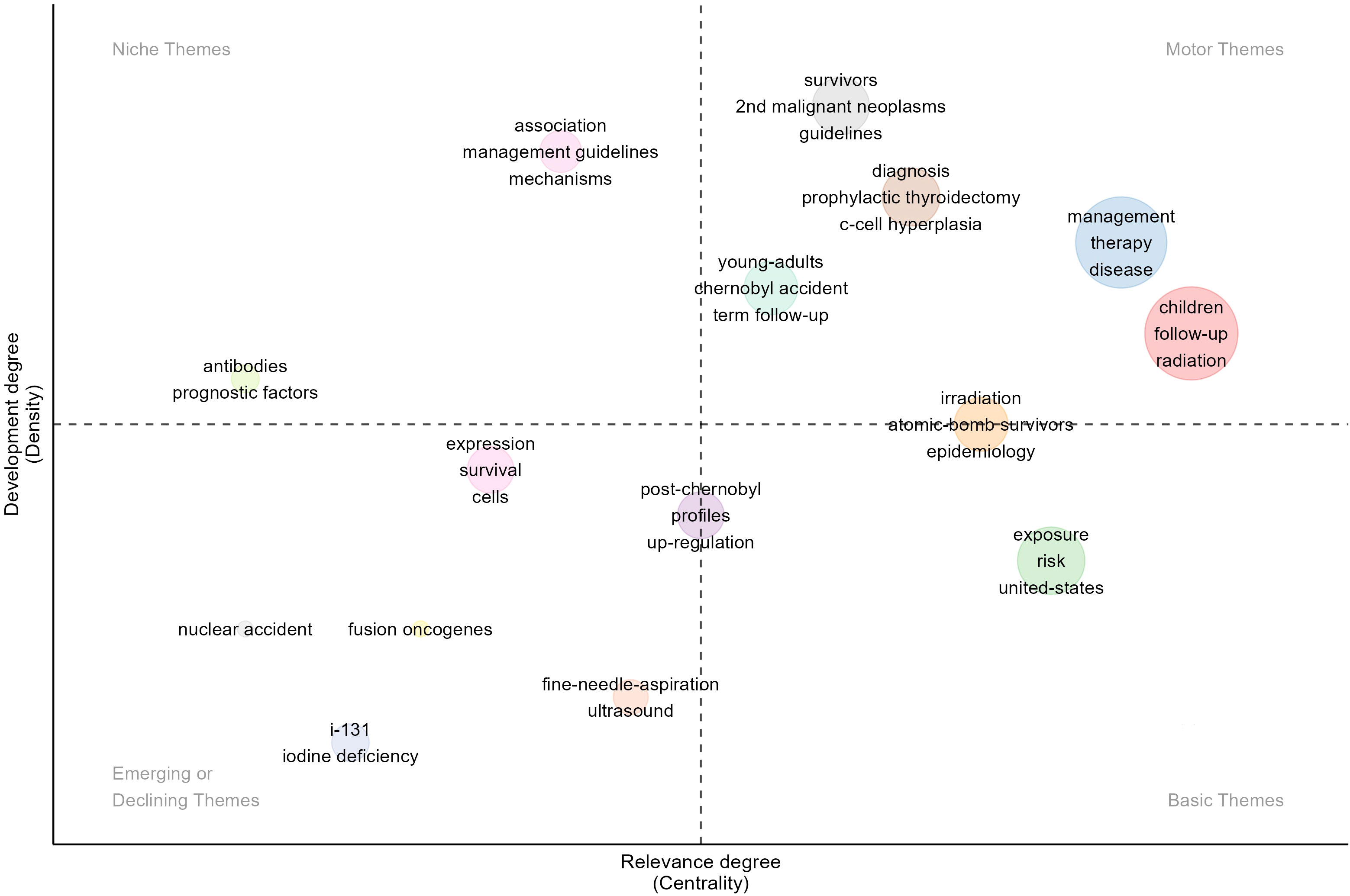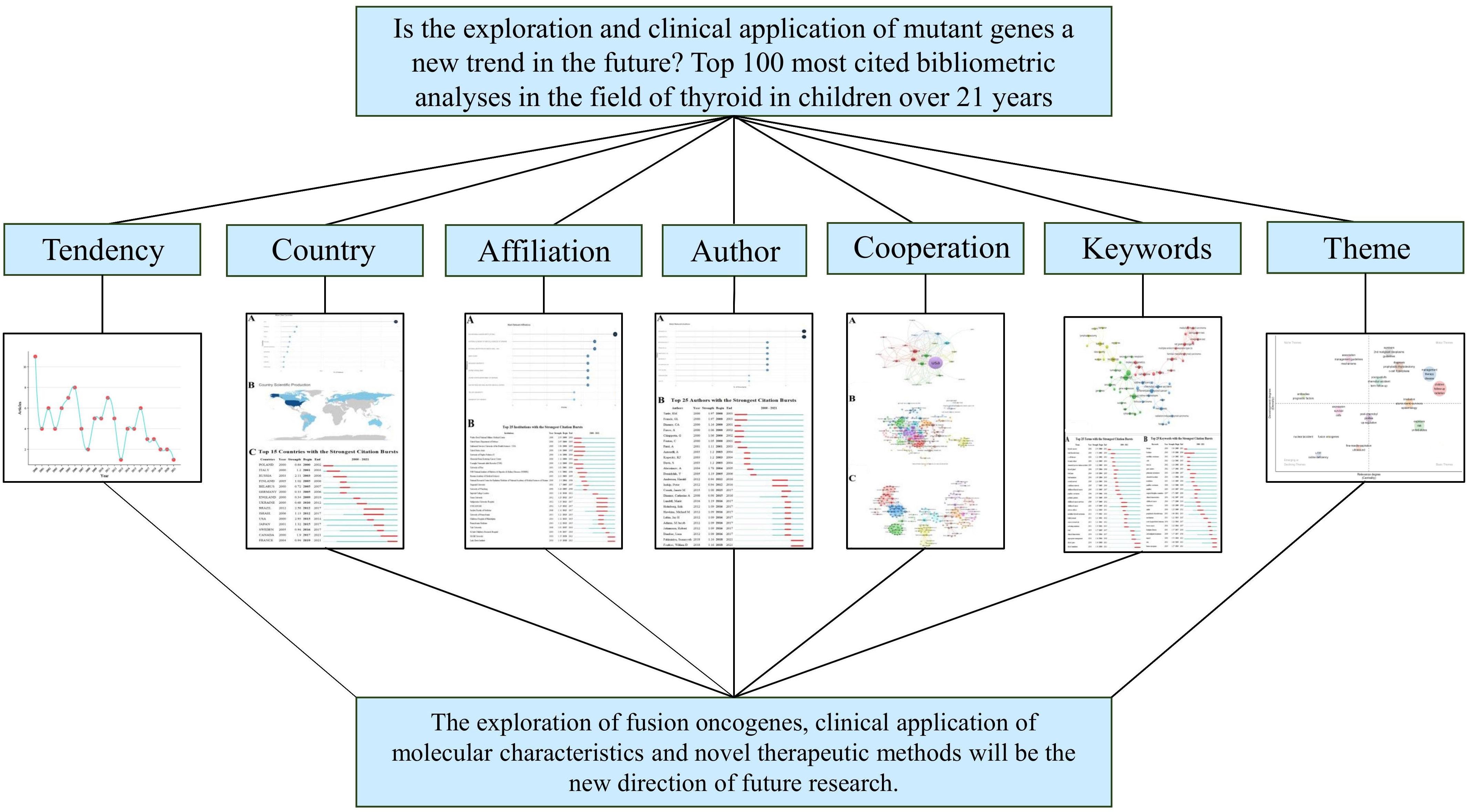- 1Department of Pathology, Second Affiliated Hospital of Guangxi Medical University, Nanning, China
- 2Department of Pathology, First Affiliated Hospital of Guangxi Medical University, Nanning, China
- 3Department of Medical Oncology, First Affiliated Hospital of Guangxi Medical University, Nanning, China
- 4Department of Nuclear Medicine, First Affiliated Hospital of Guangxi Medical University, Nanning, China
Objective: At present, the structure of knowledge in the field of childhood thyroid cancer is not clear enough, and scholars lack a sufficient understanding of the developing trends in this field, which has led to a shortage of forward-looking outputs. The purpose of this research is to help scholars construct a complete knowledge framework and identify current challenges, opportunities, and development trends.
Methods: We searched the literature in the Web of Science Core Collection database on August 7, 2023 and extracted key information from the top 100 most cited articles, such as the countries, institutions, authors, themes, and keywords. We used bibliometric tools such as bibliometrix, VOSviewer, and CiteSpace for a visualization analysis and Excel for statistical descriptions.
Results: The top 100 most cited articles fluctuated over time, and the research was concentrated in European countries, the United States, and Japan, among which scientific research institutions and scholars from the United States made outstanding contributions. Keyword analysis revealed that research has shifted from simple treatment methods for pediatric thyroid cancer (total thyroidectomy) and inducing factors (the Chernobyl power station accident) to the clinical applications of genetic mutations (such as the BRAF and RET genes) and larger-scale genetic changes (mutation studies of the DICER1 gene). The thematic strategy analysis showed an increasing trend towards the popularity of fusion oncogenes, while the popularity of research on traditional treatments and diagnostics has gradually declined.
Conclusion: Extensive research has been conducted on the basic problems of pediatric thyroid cancer, and there has been significant outputs in the follow-up and cohort analysis of conventional diagnostic and treatment methods. However, these methods still have certain limitations. Therefore, scholars should focus on exploring fusion genes, the clinical applications of molecular targets, and novel treatment methods. This study provides a strong reference for scholars in this field.
1 Introduction
During the period from 2012 to 2016, thyroid cancer held a dominant position among pediatric endocrine cancers, with an incidence rate exceeding 6% of all childhood cancers. This data highlights a consistent upward trend in the incidence of pediatric thyroid cancer over the past four decades (1). Pediatric thyroid cancer patients have a poorer prognosis, higher rates of metastasis, and lower chances of survival. Research indicates that oncogenic gene fusions are more prevalent in pediatric thyroid carcinoma, with approximately 50–60% of pediatric patients exhibiting such fusions, compared to 15% in the adult population (2). Previous studies have shown that the causes of pediatric thyroid cancer are complex, including radiation exposure (3–6), iodine deficiency (7), and various non-exposure factors (8). Furthermore, there are quantitative and qualitative differences in gene mutations and growth factor expression patterns in pediatric thyroid cancer compared to the adult variant, as well as differences in symptoms and clinical manifestations, which pose challenges to diagnosis and treatment (9). Therefore, it is crucial to strengthen the research on and our understanding of pediatric thyroid cancer to improve patient survival and quality of life. Currently, with the increasing use of computed tomography (CT) imaging for pediatric patients and the growing psychological pressure they face (10, 11), new challenges are arising in the field of pediatric thyroid cancer.
Currently, a large number of original studies and clinical guidelines have accumulated in the field of pediatric thyroid cancer. The main research focuses on the fine-needle aspiration diagnosis, treatment strategies, and case analysis of pediatric thyroid cancer. However, due to the disorganized knowledge structure and lack of systematic reviews on this disease, there have been few prospective breakthroughs in recent years. At the same time, it is difficult to discern the historical evolution of and future trends in this field.
Bibliometric analysis can effectively address these issues. Bibliometrics holds significant importance in research fields. Through systematic analysis of factors such as document quantity, citations, and author relationships, bibliometrics can reveal trends in disciplinary development, research hotspots, and knowledge gaps, providing a comprehensive perspective for scientific research. This approach not only aids in assessing the quality and impact of research but also guides future research directions, fostering collaboration and communication between disciplines. In summary, bibliometrics serves as a crucial tool in the academic community, driving the development of scholarly research and optimizing resource allocation. Therefore, in this study, we performed a bibliometric analysis of the top 100 most cited articles on pediatric thyroid cancer to enhance researchers’ understanding of this field. We explored the studies’ basic information on research output, countries, institutions, authors, collaborations, thematic evolution, keyword coupling, and strategic analysis of topics, which will promote the development of research in this field and facilitate new discoveries in basic research (12).
2 Materials and methods
2.1 Data collection
We searched for papers in the field of pediatric thyroid cancer research through the Web of Science Core Collection database up to August 7, 2023. The search strategy was as follows: TS = [(“thyroid” OR “thyroid gland” OR “thyroidea” OR “glandula thyroidea” OR “TG”) and (“cancer” OR “tumor” OR “carcinoma” OR “neoplasm” OR “neoplasia” OR “malignancy” OR “malignant”) AND (“child” OR “children”)], with the results sorted in descending order of citation frequency. The research was independently screened by two investigators, who carefully read the titles, abstracts, and full texts of each paper to confirm their relevance to pediatric thyroid cancer research, and the disagreements were resolved by a third investigator. In the end, we identified the 100 most cited papers related to thyroid cancer in children. The literature was exported in full record formats, such as plain text files, BibTex, and Excel.
2.2 Data analysis
In this study, Bibliometrix (13), VOSviewer (14), and Citespace (15) were used for bibliometric analysis. The authors, institutions, countries, and publications were networked and visualized. Bibliometrix was used to build various publication trend charts and conduct a strategic theme analysis. VOSviewer was used for a collaborative network visualization analysis of the countries, institutions and authors. Citespace was used to analyze the countries, institutions, authors, topics, and keyword emergence for each paper. Descriptive statistics were calculated using Excel. These visualization analyses can help scholars determine the research structure, hot topics, and development trends in the field, providing guidance for future research.
3 Results
3.1 Basic information
As shown in Table 1, the top 100 most cited articles include 74 original studies, 11 conference papers, and 15 review articles published from 2000 to 2021.The articles came from 50 different journals and involved 653 authors. The publication trend analysis showed that the largest number of articles were published in 2000, followed by a decline of -10.79% from 2000 to 2021. However, there were several significant fluctuations in 2006, 2011, and 2016 (Figure 1). In addition, the proportion of articles that involved international cooperations was as high as 38%.
3.2 Research output at the national level
In terms of citation frequency, the United States had the highest number of citations (n = 5730), far ahead of other countries, followed by France (n = 783) and Japan (n = 681) (Figure 2A). The scientific outputs are shown in Figure 2B. These research outputs were concentrated in European, North American countries and South American countries, of which the United States had the largest scientific output. Among Asian countries, only Japan devoted significant effort to research on childhood thyroid cancer. Additionally, some African countries and Australia were interested in this field. To explore the impacts of different countries over time, we conducted an emergent analysis of the top 15 most influential countries (Figure 2C). Around 2000, Poland, Italy, and Russia made significant contributions. Brazil and Israel had the largest influence between 2012 and 2017.
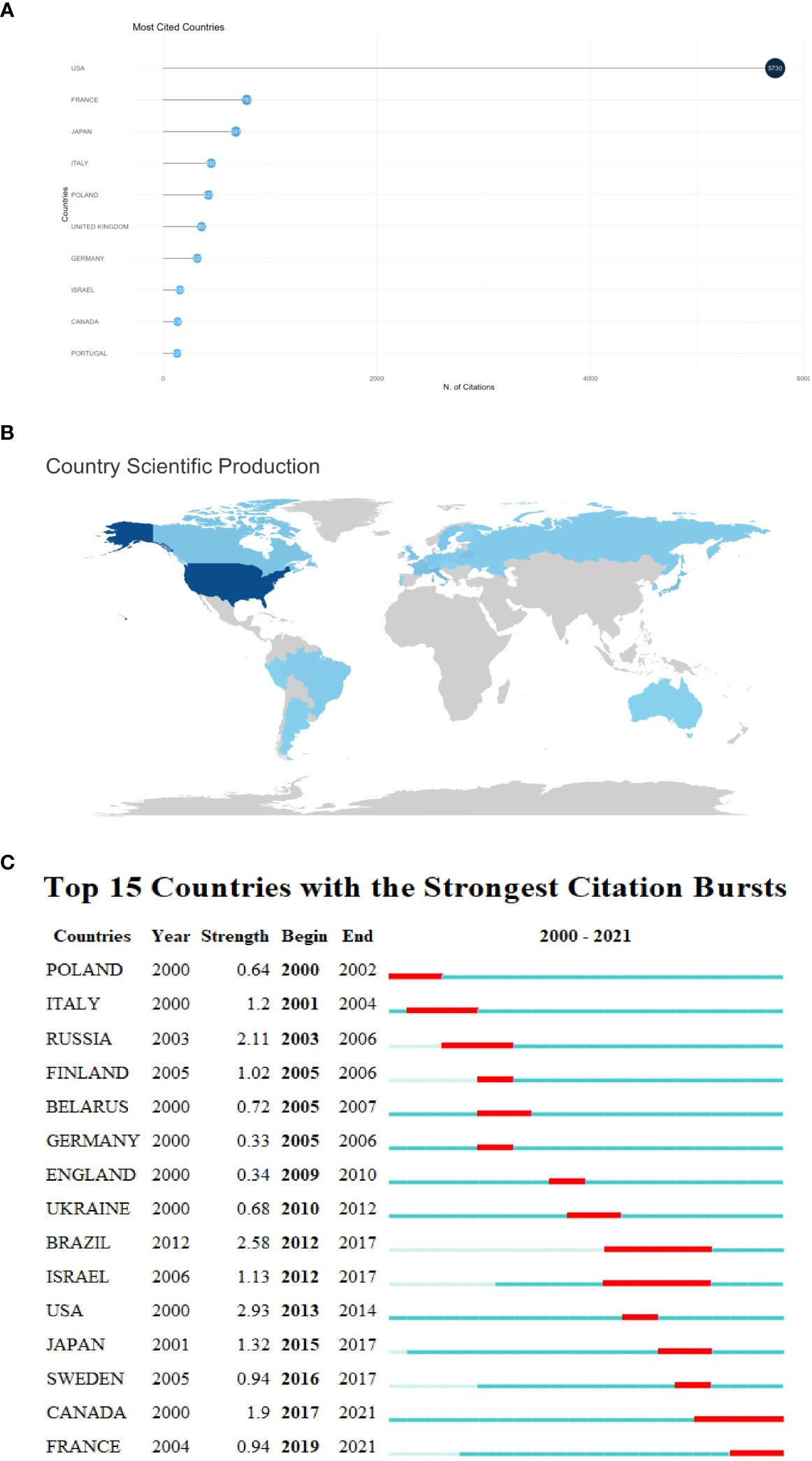
Figure 2 Country-level analysis: (A) Most cited countries. (B) Country research output map. (C) Country emergence.
3.3 Scientific research output at the institutional level
A visualization analysis of the top 10 research institutions, presented in Figure 3, showed that the National Cancer Institute (NCI) in the United States (n = 15) had the highest research output on pediatric thyroid cancer. Examining the top 25 of the 49 most influential institutions revealed that most of the research institutions were in the United States, such as the Walter Reed National Military Medical Center, United States Department of Defense, and Uniformed Services University of the Health Sciences, which contributed foundational research in the early development of this field. In these 21 years, institutions from the United States had a significant impact. In addition, Umea University, Sahlgrenska University Hospital, UNICANCER, and other scientific research institutions from European countries had long-lasting influence in this field.
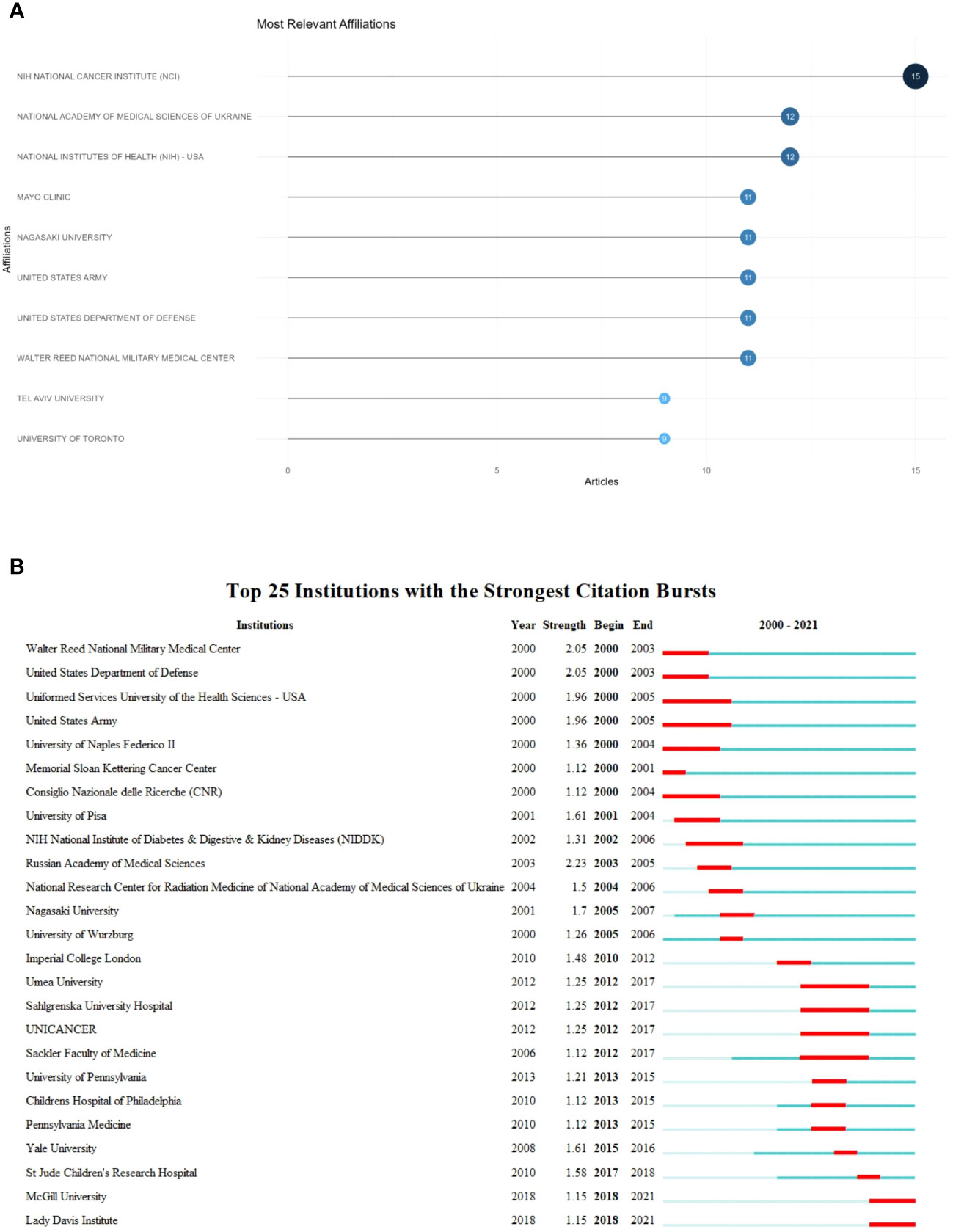
Figure 3 Institution-level analysis: (A) Top 10 most influential institutions. (B) Institutional emergence.
3.4 Scientific research output at the author level
A visualization analysis of the ten most relevant authors showed that Dinauer and Yamashita produced the most articles, with seven publications each. Bogdanova, Francis, Nikiforov, and other authors also made notable contributions (n = 5) (Figure 4A). Emergence analysis of the top 25 authors in Figure 4B revealed that Anderson and Inskip had the longest-lasting impacts. In recent years, Fahiminiya and Foulkes have made significant contributions.
3.5 Cooperation
We built a network of cooperation at the countries (Figure 5A), institutions (Figure 5B), and author (Figure 5C) levels, with connections between nodes representing cooperative relationships and node sizes representing the corresponding frequency of occurrences. We found that the cooperation between countries was relatively close, with strong collaboration among countries such as the United States, Germany, England, Italy, Japan, and Belarus. Institutions worked even more closely together than countries did, and at the center of the cooperative network was the NCI. The cooperation among authors was distributed in clusters, with a total of 10 clusters.
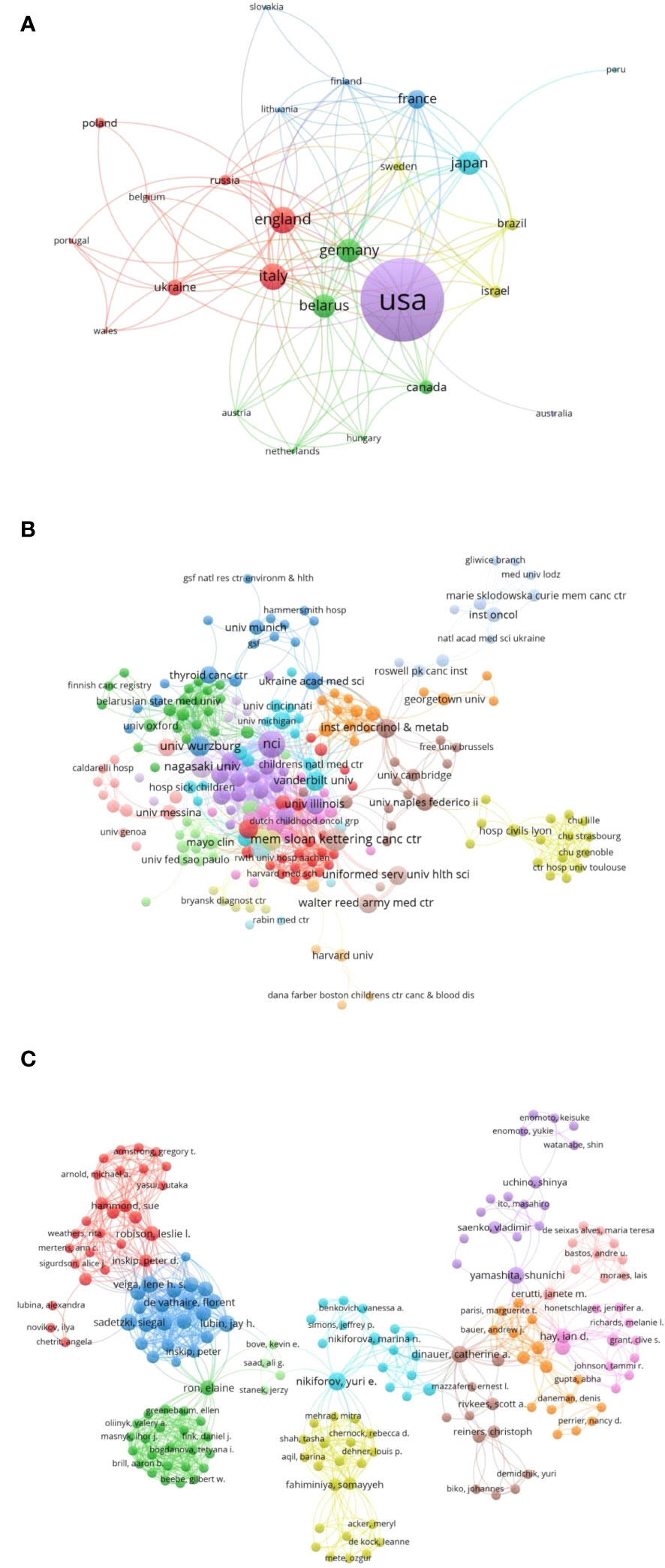
Figure 5 Cooperative networks: (A) Country cooperation. (B) Institutional cooperation. (C) Author cooperation.
3.6 Theme and keyword analysis
3.6.1 Evolution of themes and keywords
We further analyzed the evolution of historical hot topics and keywords as well as the transformation of knowledge. A comprehensive examination of the 100 studies and analysis of sudden changes in themes showed that the research touched on total thyroidectomy, the Chernobyl power station accident, some unique molecular pathological changes (the BRAF and RET genes), and clinical characteristics of the disease (overall survival and confidence interval). Later, the focus shifted to the clinical applications of gene mutations and a broader range of characteristic gene mutations, such as the DICER1 gene and activating mutations (Figure 6A). Based on the theme evolution, we further explored the keyword evolution (Figure 6B), which showed a trend that was similar to that of the topic evolution. The keyword “mechanisms,” proposed in recent years, deserves special attention.
3.6.2 Keyword coupling
To accurately reproduce the knowledge composition and research framework of childhood thyroid cancer, 62 high-frequency keywords were extracted from 100 articles to construct a coupling network (Figure 7). The coupled networks were divided into four clusters: a green cluster for causes of thyroid cancer in children (such as the Chernobyl incident, oncogenes, and gene expression); a red cluster for the diagnosis and treatment of thyroid cancer in children (such as therapy, surgery, radioiodine, and the omeprazole test); a blue cluster for different types of childhood thyroid cancer (such as differentiated thyroid cancer, radiation-induced thyroid carcinoma, and follicular carcinoma); and a yellow cluster for clinical survival analysis and related experiments (on survival, data quality, registries, etc.).
3.6.3 Thematic strategic analysis
Finally, to help scholars accurately determine the direction of the evolution of childhood thyroid cancer and the development potential of different themes, we conducted a thematic strategic coordination analysis (Figure 8). The results showed that there were five clusters located in the first quadrant; with high centrality and density, these were the hotspots and core themes. These themes were summarized as follow-up after radiotherapy, treatment management, diagnosis and prevention, and secondary primary tumors. The second quadrant represented isolated themes with strong internal but weak external connections, including “antibodies,” “prognosis factors,” and “mechanisms.” The themes in the third quadrant had low centrality and density, indicating emerging or declining topics, such as “nuclear accident,” “fusion oncogenes,” “i-131,” “iodine deficiency,” “fine-needle-aspiration,” and “ultrasound”. The basic themes in the fourth quadrant had high centripetal degrees, including “exposure” and “risk”. Additionally, we observed that there were two class clusters at the intersection of two quadrants. “Atomic-bomb survivors” and “irradiation” were at the intersection of the first and fourth quadrants, indicating increasing research interest. “Post-Chernobyl,” “profiles,” and “up-regulation” were at the intersection of the third and fourth quadrants.
4 Discussion
Bibliometrics is the systematic study of academic publishing and uses statistics to describe publishing trends and highlight relationships between published works (10). We used bibliometric research to visualize the overall publications and the countries, institutions, authors and partnerships, changes in thematic trends, and potential future directions of the top 100 most cited articles in the field of childhood thyroid cancer (Figure 9). More importantly, we aimed to provide a comprehensive reference for relevant clinicians and researchers to help them identify the most active scientific frontiers.
4.1 Research highlights
This study conducted a thorough and comprehensive analysis of the field of pediatric thyroid cancer. From the perspective of basic research information, the study included the top 100 most-cited articles from 2000 to 2021, covering various types of literature, journals, and research authors, revealing the developmental trajectory of this field. The publication trend showed a decline after reaching its peak in 2000, but the fluctuations indicated the ongoing vitality of the field. Moreover, the high percentage of international collaboration reflects a global interest in pediatric thyroid cancer research. The United States emerged as a leader in pediatric thyroid cancer research, with significant research outputs also observed in other countries such as France and Japan. The National Cancer Institute dominates this field, while some research institutions in European countries have had a lasting impact. Dinauer and Yamashita made remarkable contributions, and the sustained influence of Anderson Harald and Inskip Peter signifies their long-term contributions to the field. Collaboration among countries, institutions, and authors is tight, forming a complex collaborative network. Theme and keyword analysis revealed the evolution of pediatric thyroid cancer research from treatment methods and molecular pathological changes to broader characteristic genetic mutations. The introduction of the keyword “mechanisms” has garnered widespread attention. Finally, the strategic analysis of themes provides comprehensive insights into the field of pediatric thyroid cancer, offering crucial references for future research directions and strategies. In the following sections, we provide a detailed description and discussion of the aforementioned research results.
4.2 Temporal distribution of research output
From the perspective of publication trends and basic research conditions, the publication trend of childhood thyroid cancer research has exhibited significant fluctuations, especially in 2000, 2006, 2011, and 2016. Based on the strong association between radiation exposure and the risk of thyroid cancer in children (16), we speculate that these fluctuations are related to the 1999 nuclear leak in Japan, the 2005 leak of large amounts of radioactive liquid from the largest nuclear power plant in the United Kingdom, the 2011 Fukushima nuclear leak in Japan, and the radioactive iodine leak from a Norwegian nuclear reactor in 2016.
4.3 Analysis at the national, institutional, and author levels
European and American institutions and scientists have made especially important contributions to this research. The NCI has had the largest influence of any research institution and occupies a central position in the research co-authorship network. This is largely due to the agency producing the earliest systematic study of thyroid cancer risk in children and exposure to a dose of I131 (17–22). In addition, it may be related to the breakthrough achievements of the NCI in the detection of genetic mutations in thyroid cancer, such as the discovery that RET oncogene mutations contribute to the use of prophylactic thyroidectomy in children (23). Anderson and Inskip have the longest-lasting research influence in the field. The two have devoted years of research to the risk of thyroid cancer after radiotherapy in children and to cohort analyses, finding that the risk of thyroid cancer after radiotherapy for childhood cancer is significantly increased (6, 24–30). European countries and Japan have also made great contributions to this research field. This is due to the large number of children exposed to radiation and the large increase in radioactive iodine intake after the Chernobyl and Fukushima accidents (18, 31, 32). The cooperation network among authors at the national and institutional levels shows that the research is networked and cooperative, which suggests that scholars interested in this field should strengthen cooperative research. At the same time, researchers can also reference this research to find potential high-quality partners.
4.4 Analysis of keywords and topic trends
The historical context, research process, and development trends of childhood thyroid cancer are the main focus of this study. Based on the evolution, emergence, and thematic strategy analysis of theme keywords, it can be observed that the research ranges from simple treatment methods and predisposing factors of pediatric thyroid cancer to its clinical characteristics, and then further in-depth to gene mutations, molecular mechanisms, and biomarker detection. Four years after the Chernobyl nuclear accident, a dramatic increase in childhood thyroid cancer was observed in Belarus and Ukraine, and its causes; screening and treatment methods; prognosis; and clinical features need to be identified (18, 33–36). Initially, age, radiation exposure, disease risk, disease severity, and probability of recurrence were strongly correlated, suggesting that children are at higher risk of radiation-related thyroid cancer than adults (37–39). Early studies have reported routine examinations of thyroid nodules, such as fine needle aspiration and neck ultrasound (40–42). Treatment has mainly concentrated on total thyroidectomy, radioactive iodine therapy, and follow-up or related cohort analyses throughout the study phase. Unfortunately, both surgical methods seem to have certain drawbacks. Total thyroidectomy is considered the best treatment option to some extent (43), but postoperative effects may persist, leading to complications such as hypocalcemia, hematoma, recurrent laryngeal nerve injury, and hypoparathyroidism (44, 45). In differentiated thyroid cancer in childhood, radioactive iodine therapy provides specific survival benefits (46), but there is an increased risk of a second primary malignancy and radiation fibrosis after treatment (47). In earlier years, scholars noted characteristic genetic mutations related to childhood thyroid cancer. Radiation-specific thyroid cancer in children has been associated with ret/PTC rearrangements occurring more frequently and generates new rearrangements (PTC8) in radiation-induced childhood thyroid cancer, and it is specific to this age group (48). In addition, numerous studies have discovered that BRAF mutations, which are common in adult thyroid cancer, are not the predominant molecular event in pediatric thyroid cancer (49–51). Unfortunately, the research at that time was limited to the mutation expression of BRAF, but did not explore its clinical application or its relationship with survival prognosis. Subsequently, under the influence of nuclear leakage incidents around the world, childhood thyroid cancer has gradually attracted the attention of more scholars globally, and the research has moved beyond characterization towards breakthroughs in treatment, diagnosis, and genetic mechanisms (52–54). In terms of treatment, for example, vandetanib targeted therapy has emerged as a highly active new treatment for children and adolescents with locally advanced or metastatic medullary thyroid cancer who tolerate it well (55). More and more scholars are focusing on the study of the molecular mechanism and gene expression of thyroid cancer in children. In radiation-induced childhood thyroid cancer, many regions of copy number alteration have been detected in specific genes or chromosomes in the genome, which may serve as potential markers (56). In addition, the increase in chromosomal band 7q11 and specific overexpression of genes such as CLIP2 after exposure to low doses of radiation may be specific molecular markers of thyroid cancer in children (57). Therefore, regarding the theme of the third quadrant of the thematic strategy map, it can be confirmed that with the continuous development of molecular targets, traditional diagnostic treatments, such as fine-needle-aspiration, ultrasound, and i-131 are diminishing, and fusion oncogenes are the subject of increasing research. The clinical pathological differences observed between children and adults may be attributed to different genetic alterations, of which fusion oncogenes are the main type, and fusion gene expression and aggressiveness are closely related (58, 59).
However, from the above research progression, it can be seen that effective clinical treatments for childhood thyroid cancer need to be explored to reduce side effects. At the same time, the potential value of molecular targets in the diagnosis of thyroid cancer in children is worth further exploiting.
4.5 Limitations of the study
Inevitably, there are certain limitations to this study. It only includes literature in English, and there may thus be a limited representation of high-quality literature in other languages. In addition, high-quality prospective studies published in recent years were not considered because of their recent appearance and low citation frequency. Importantly, it doesn’t imply lower quality or importance of articles from 2022 and 2023 compared to those from 2000 to 2021. It only reflects that, at data cutoff, recent articles hadn’t accumulated enough citations. In the future, we will conduct a larger bibliometric analysis to solve the above problems.
5 Conclusion
A bibliometric analysis of the top 100 most cited papers over the past 21 years found significant correlations between the research hotspots and outputs and the country or time of radiation leaks. Many nuclear leak incidents in the world have led to large-scale outbreaks of childhood thyroid cancer, but its unique molecular clinical characteristics have not been widely considered in diagnosis, treatment, and prognosis. Conventional treatment methods still have certain limitations. With the increasing use of CT imaging in pediatric patients and the growing psychological stress faced by children, pediatric thyroid dysfunction and thyroid cancer in children may face greater challenges. This study aims to help scholars worldwide better understand the developmental trends in pediatric thyroid cancer research, focusing on exploring fusion genes, clinical applications of molecular features, and novel treatment methods, in order to address this global issue as soon as possible.
Author contributions
CS: Formal Analysis, Visualization, Writing – original draft. J-YL: Methodology, Resources, Software, Supervision, Writing – review & editing. Y-YP: Funding acquisition, Methodology, Resources, Software, Supervision, Writing – review & editing. R-QH: Methodology, Supervision, Writing – review & editing. X-JL: Methodology, Supervision, Writing – review & editing. GC: Conceptualization, Data curation, Funding acquisition, Project administration, Validation, Writing – review & editing. C-YZ: Formal Analysis, Investigation, Visualization, Writing – original draft. NQ: Formal Analysis, Investigation, Visualization, Writing – original draft. Y-MC: Formal Analysis, Investigation, Visualization, Writing – original draft. LY: Conceptualization, Data curation, Formal Analysis, Project administration, Validation, Writing – review & editing. B-QL: Conceptualization, Data curation, Formal Analysis, Project administration, Writing – review & editing. LS: Formal Analysis, Project administration, Validation, Writing – review & editing.
Funding
The author(s) declare financial support was received for the research, authorship, and/or publication of this article. This work was supported by the Plan of Cultivating Excellent Reserve Talents of the Second Affiliated Hospital of Guangxi Medical University (HBRC201804), the Guangxi Zhuang Autonomous Region Health Commission Self-financed Scientific Research Project (Z20201138, Z-A20220521), the National College Students’ innovation and entrepreneurship training program (202310598042), the Guangxi Higher Education Undergraduate Teaching Reform Project (2022JGA146), the Guangxi Educational Science Planning Key Project (2022ZJY2791), and the Guangxi Medical University Undergraduate Education and Teaching Reform Project (2023Z10).
Acknowledgments
Thanks for the technical support provided by the Guangxi Zhuang Autonomous Region Clinical Medicine Research Center for Molecular Pathology and Intelligent Pathology Precision Diagnosis.
Conflict of interest
The authors declare that the research was conducted in the absence of any commercial or financial relationships that could be construed as a potential conflict of interest.
Publisher’s note
All claims expressed in this article are solely those of the authors and do not necessarily represent those of their affiliated organizations, or those of the publisher, the editors and the reviewers. Any product that may be evaluated in this article, or claim that may be made by its manufacturer, is not guaranteed or endorsed by the publisher.
Abbreviations
CT, Computed Tomography; NCI, National Cancer Institute.
References
1. Paulson VA, Rudzinski ER, Hawkins DS. Thyroid cancer in the pediatric population. Genes (2019) 10(9):723. doi: 10.3390/genes10090723
2. Siegel RL, Miller KD, Wagle NS, Jemal A. Cancer statistics, 2023. CA: Cancer J Clin (2023) 73(1):17–48. doi: 10.3322/caac.21763
3. Zupunski L, Ostroumova E, Drozdovitch V, Veyalkin I, Ivanov V, Yamashita S, et al. Thyroid cancer after exposure to radioiodine in childhood and adolescence: (131)I-related risk and the role of selected host and environmental factors. Cancers (2019) 11(10):1481. doi: 10.3390/cancers11101481
4. Tronko MD, Howe GR, Bogdanova TI, Bouville AC, Epstein OV, Brill AB, et al. A cohort study of thyroid cancer and other thyroid diseases after the chornobyl accident: thyroid cancer in Ukraine detected during first screening. J Natl Cancer Institute. (2006) 98(13):897–903. doi: 10.1093/jnci/djj244
5. Zablotska LB, Ron E, Rozhko AV, Hatch M, Polyanskaya ON, Brenner AV, et al. Thyroid cancer risk in Belarus among children and adolescents exposed to radioiodine after the Chornobyl accident. Br J cancer. (2011) 104(1):181–7. doi: 10.1038/sj.bjc.6605967
6. Veiga LH, Holmberg E, Anderson H, Pottern L, Sadetzki S, Adams MJ, et al. Thyroid cancer after childhood exposure to external radiation: an updated pooled analysis of 12 studies. Radiat Res (2016) 185(5):473–84. doi: 10.1667/RR14213.1
7. Zimmermann MB, Galetti V. Iodine intake as a risk factor for thyroid cancer: a comprehensive review of animal and human studies. Thyroid Res (2015) 8:8. doi: 10.1186/s13044-015-0020-8
8. Enomoto Y, Enomoto K, Uchino S, Shibuya H, Watanabe S, Noguchi S. Clinical features, treatment, and long-term outcome of papillary thyroid cancer in children and adolescents without radiation exposure. World J surgery. (2012) 36(6):1241–6. doi: 10.1007/s00268-012-1558-4
9. Piccardo A, Fiz F, Bottoni G, Foppiani L, Albano D, Bertagna F, et al. Does it work in childhood and adolescence? The predictive role of postoperative/preablative stimulated thyroglobulin levels in paediatric thyroid cancer. A systematic review of the literature. Rev endocrine Metab Disord (2023) 25(1):53–63. doi: 10.1007/s11154-023-09835-z
10. Chen AY, Davies L. Children and thyroid cancer: Interpreting troubling trends. Cancer (2019) 125(14):2359–61. doi: 10.1002/cncr.32124
11. Kyriacou A, Tziaferi V, Toumba M. Stress, thyroid dysregulation, and thyroid cancer in children and adolescents: proposed impending mechanisms. Hormone Res paediatrics. (2023) 96(1):44–53. doi: 10.1159/000524477
12. Gao M, Zhang H, Wang C, Mou X, Zhu Q, Wang J, et al. Top 100 cited papers on premenstrual syndrome/premenstrual dysphoric disorder: A bibliometric study. Front Psychiatry (2022) 13:936009. doi: 10.3389/fpsyt.2022.936009
13. Aria M, Cuccurullo C. bibliometrix: An R-tool for comprehensive science mapping analysis. J Informetrics. (2017) 11(4):959–75. doi: 10.1016/j.joi.2017.08.007
14. van Eck NJ, Waltman L. Software survey: VOSviewer, a computer program for bibliometric mapping. Scientometrics (2010) 84(2):523–38. doi: 10.1007/s11192-009-0146-3
15. Chen C. CiteSpace II: Detecting and visualizing emerging trends and transient patterns in scientific literature. J Am Soc Inf Sci Technology. (2006) 57(3):359–77. doi: 10.1002/asi.20317
16. Ho WL, Zacharin MR. Thyroid carcinoma in children, adolescents and adults, both spontaneous and after childhood radiation exposure. Eur J pediatrics. (2016) 175(5):677–83. doi: 10.1007/s00431-016-2692-z
17. Bogdanova TI, Saenko VA, Hashimoto Y, Hirokawa M, Zurnadzhy LY, Hayashi T, et al. Papillary thyroid carcinoma in Ukraine after chernobyl and in Japan after fukushima: different histopathological scenarios. Thyroid: Off J Am Thyroid Assoc (2021) 31(9):1322–34. doi: 10.1089/thy.2020.0308
18. Drozd V, Saenko V, Branovan DI, Brown K, Yamashita S, Reiners C. A search for causes of rising incidence of differentiated thyroid cancer in children and adolescents after chernobyl and fukushima: comparison of the clinical features and their relevance for treatment and prognosis. Int J Environ Res Public Health (2021) 18(7):3444. doi: 10.3390/ijerph18073444
19. Fuzik M, Prysyazhnyuk A, Shibata Y, Romanenko A, Fedorenko Z, Gulak L, et al. Thyroid cancer incidence in Ukraine: trends with reference to the Chernobyl accident. Radiat Environ biophysics. (2011) 50(1):47–55. doi: 10.1007/s00411-010-0340-y
20. Ohtsuru A, Midorikawa S, Ohira T, Suzuki S, Takahashi H, Murakami M, et al. Incidence of thyroid cancer among children and young adults in fukushima, Japan, screened with 2 rounds of ultrasonography within 5 years of the 2011 fukushima daiichi nuclear power station accident. JAMA otolaryngology– Head Neck surgery. (2019) 145(1):4–11. doi: 10.1001/jamaoto.2018.3121
21. Shirahige Y, Ito M, Ashizawa K, Motomura T, Yokoyama N, Namba H, et al. Childhood thyroid cancer: comparison of Japan and Belarus. Endocrine J (1998) 45(2):203–9. doi: 10.1507/endocrj.45.203
22. Suzuki G, Ishikawa T, Ohba T, Hasegawa A, Nagai H, Miyatake H, et al. Estimation of children’s thyroid equivalent doses in 16 municipalities after the Fukushima Daiichi Nuclear Power Station accident. J Radiat Res (2022) 63(6):796–804. doi: 10.1093/jrr/rrac058
23. Cardis E, Kesminiene A, Ivanov V, Malakhova I, Shibata Y, Khrouch V, et al. Risk of thyroid cancer after exposure to 131I in childhood. J Natl Cancer Institute. (2005) 97(10):724–32. doi: 10.1093/jnci/dji129
24. Inskip PD, Veiga LHS, Brenner AV, Sigurdson AJ, Ostroumova E, Chow EJ, et al. Hyperthyroidism after radiation therapy for childhood cancer: A report from the childhood cancer survivor study. Int J Radiat oncology biology physics. (2019) 104(2):415–24. doi: 10.1016/j.ijrobp.2019.02.009
25. Inskip PD, Veiga LHS, Brenner AV, Sigurdson AJ, Ostroumova E, Chow EJ, et al. Hypothyroidism after radiation therapy for childhood cancer: A report from the childhood cancer survivor study. Radiat Res (2018) 190(2):117–32. doi: 10.1667/RR14888.1
26. Kovalchik SA, Ronckers CM, Veiga LH, Sigurdson AJ, Inskip PD, de Vathaire F, et al. Absolute risk prediction of second primary thyroid cancer among 5-year survivors of childhood cancer. J Clin Oncol (2013) 31(1):119–27. doi: 10.1200/JCO.2012.41.8996
27. Lubin JH, Adams MJ, Shore R, Holmberg E, Schneider AB, Hawkins MM, et al. Thyroid cancer following childhood low-dose radiation exposure: A pooled analysis of nine cohorts. J Clin Endocrinol Metab (2017) 102(7):2575–83. doi: 10.1210/jc.2016-3529
28. Meadows AT, Friedman DL, Neglia JP, Mertens AC, Donaldson SS, Stovall M, et al. Second neoplasms in survivors of childhood cancer: findings from the Childhood Cancer Survivor Study cohort. J Clin Oncol (2009) 27(14):2356–62. doi: 10.1200/JCO.2008.21.1920
29. Veiga LH, Bhatti P, Ronckers CM, Sigurdson AJ, Stovall M, Smith SA, et al. Chemotherapy and thyroid cancer risk: a report from the childhood cancer survivor study. Cancer epidemiology Biomarkers Prev (2012) 21(1):92–101. doi: 10.1158/1055-9965.EPI-11-0576
30. Veiga LH, Lubin JH, Anderson H, de Vathaire F, Tucker M, Bhatti P, et al. A pooled analysis of thyroid cancer incidence following radiotherapy for childhood cancer. Radiat Res (2012) 178(4):365–76. doi: 10.1667/RR2889.1
31. Ory C, Leboulleux S, Salvatore D, Le Guen B, De Vathaire F, Chevillard S, et al. Consequences of atmospheric contamination by radioiodine: the Chernobyl and Fukushima accidents. Endocrine (2021) 71(2):298–309. doi: 10.1007/s12020-020-02498-9
32. Lebel LS, Dickson RS, Glowa GA. Radioiodine in the atmosphere after the Fukushima Dai-ichi nuclear accident. J Environ radioactivity (2016) 151Pt 1:82–93. doi: 10.1016/j.jenvrad.2015.06.001
33. Leenhardt L, Aurengo A. Post-Chernobyl thyroid carcinoma in children. Bailliere’s Best Pract Res Clin Endocrinol Metab (2000) 14(4):667–77. doi: 10.1053/beem.2000.0109
34. Demidchik YE, Saenko VA, Yamashita S. Childhood thyroid cancer in Belarus, Russia, and Ukraine after Chernobyl and at present. Arquivos brasileiros endocrinologia e metabologia. (2007) 51(5):748–62. doi: 10.1590/S0004-27302007000500012
35. Drozdovitch V. Radiation exposure to the thyroid after the chernobyl accident. Front endocrinology. (2020) 11:569041. doi: 10.3389/fendo.2020.569041
36. Rybakov SJ, Komissarenko IV, Tronko ND, Kvachenyuk AN, Bogdanova TI, Kovalenko AE, et al. Thyroid cancer in children of Ukraine after the Chernobyl accident. World J surgery. (2000) 24(11):1446–9. doi: 10.1007/s002680010239
37. Saad AG, Kumar S, Ron E, Lubin JH, Stanek J, Bove KE, et al. Proliferative activity of human thyroid cells in various age groups and its correlation with the risk of thyroid cancer after radiation exposure. J Clin Endocrinol Metab (2006) 91(7):2672–7. doi: 10.1210/jc.2006-0417
38. Alessandri AJ, Goddard KJ, Blair GK, Fryer CJ, Schultz KR. Age is the major determinant of recurrence in pediatric differentiated thyroid carcinoma. Med Pediatr Oncol (2000) 35(1):41–6. doi: 10.1002/1096-911X(200007)35:1<41::AID-MPO7>3.0.CO;2-7
39. Farahati J, Demidchik EP, Biko J, Reiners C. Inverse association between age at the time of radiation exposure and extent of disease in cases of radiation-induced childhood thyroid carcinoma in Belarus. Cancer (2000) 88(6):1470–6. doi: 10.1002/(SICI)1097-0142(20000315)88:6<1470::AID-CNCR27>3.0.CO;2-W
40. Corrias A, Einaudi S, Chiorboli E, Weber G, Crinò A, Andreo M, et al. Accuracy of fine needle aspiration biopsy of thyroid nodules in detecting Malignancy in childhood: comparison with conventional clinical, laboratory, and imaging approaches. J Clin Endocrinol Metab (2001) 86(10):4644–8. doi: 10.1210/jcem.86.10.7950
41. Antonelli A, Miccoli P, Fallahi P, Grosso M, Nesti C, Spinelli C, et al. Role of neck ultrasonography in the follow-up of children operated on for thyroid papillary cancer. Thyroid (2003) 13(5):479–84. doi: 10.1089/105072503322021142
42. Lyshchik A, Drozd V, Demidchik Y, Reiners C. Diagnosis of thyroid cancer in children: value of gray-scale and power doppler US. Radiology (2005) 235(2):604–13. doi: 10.1148/radiol.2352031942
43. Spinelli C, Bertocchini A, Antonelli A, Miccoli P. Surgical therapy of the thyroid papillary carcinoma in children: experience with 56 patients < or =16 years old. J Pediatr Surg (2004) 39(10):1500–5. doi: 10.1016/j.jpedsurg.2004.06.016
44. Balentine CJ, Sippel RS. Outpatient thyroidectomy: is it safe? Surg Oncol Clinics North America (2016) 25(1):61–75. doi: 10.1016/j.soc.2015.08.003
45. Bargren AE, Meyer-Rochow GY, Delbridge LW, Sidhu SB, Chen H. Outcomes of surgically managed pediatric thyroid cancer. J Surg Res (2009) 156(1):70–3. doi: 10.1016/j.jss.2009.03.088
46. Jarzab B, Handkiewicz-Junak D, Wloch J. Juvenile differentiated thyroid carcinoma and the role of radioiodine in its treatment: a qualitative review. Endocrine-related cancer. (2005) 12(4):773–803. doi: 10.1677/erc.1.00880
47. Pawelczak M, David R, Franklin B, Kessler M, Lam L, Shah B. Outcomes of children and adolescents with well-differentiated thyroid carcinoma and pulmonary metastases following ¹³¹I treatment: a systematic review. Thyroid (2010) 20(10):1095–101. doi: 10.1089/thy.2009.0446
48. Fenton CL, Lukes Y, Nicholson D, Dinauer CA, Francis GL, Tuttle RM. The ret/PTC mutations are common in sporadic papillary thyroid carcinoma of children and young adults. J Clin Endocrinol Metab (2000) 85(3):1170–5. doi: 10.1210/jc.85.3.1170
49. Lima J, Trovisco V, Soares P, Máximo V, Magalhães J, Salvatore G, et al. BRAF mutations are not a major event in post-Chernobyl childhood thyroid carcinomas. J Clin Endocrinol Metab (2004) 89(9):4267–71. doi: 10.1210/jc.2003-032224
50. Penko K, Livezey J, Fenton C, Patel A, Nicholson D, Flora M, et al. BRAF mutations are uncommon in papillary thyroid cancer of young patients. Thyroid (2005) 15(4):320–5. doi: 10.1089/thy.2005.15.320
51. Rosenbaum E, Hosler G, Zahurak M, Cohen Y, Sidransky D, Westra WH. Mutational activation of BRAF is not a major event in sporadic childhood papillary thyroid carcinoma. Modern Pathol (2005) 18(7):898–902. doi: 10.1038/modpathol.3800252
52. Bauer AJ. Molecular genetics of thyroid cancer in children and adolescents. Endocrinol Metab Clinics North America. (2017) 46(2):389–403. doi: 10.1016/j.ecl.2017.01.014
53. Bauer AJ. Pediatric thyroid cancer: genetics, therapeutics and outcome. Endocrinol Metab Clinics North America. (2020) 49(4):589–611. doi: 10.1016/j.ecl.2020.08.001
54. Dinauer CA, Breuer C, Rivkees SA. Differentiated thyroid cancer in children: diagnosis and management. Curr Opin Oncol (2008) 20(1):59–65. doi: 10.1097/CCO.0b013e3282f30220
55. Fox E, Widemann BC, Chuk MK, Marcus L, Aikin A, Whitcomb PO, et al. Vandetanib in children and adolescents with multiple endocrine neoplasia type 2B associated medullary thyroid carcinoma. Clin Cancer Res (2013) 19(15):4239–48. doi: 10.1158/1078-0432.CCR-13-0071
56. Stein L, Rothschild J, Luce J, Cowell JK, Thomas G, Bogdanova TI, et al. Copy number and gene expression alterations in radiation-induced papillary thyroid carcinoma from chernobyl pediatric patients. Thyroid (2010) 20(5):475–87. doi: 10.1089/thy.2009.0008
57. Hess J, Thomas G, Braselmann H, Bauer V, Bogdanova T, Wienberg J, et al. Gain of chromosome band 7q11 in papillary thyroid carcinomas of young patients is associated with exposure to low-dose irradiation. Proc Natl Acad Sci United States America. (2011) 108(23):9595–600. doi: 10.1073/pnas.1017137108
58. Pekova B, Sykorova V, Dvorakova S, Vaclavikova E, Moravcova J, Katra R, et al. BRAF, and MET fusions in a large cohort of pediatric papillary thyroid carcinomas. Thyroid (2020) 30(12):1771–80. doi: 10.1089/thy.2019.0802
Keywords: childhood thyroid cancer, bibliometrics, radiation exposure, genetic mutations, molecular targets
Citation: Song C, Luo J-Y, Pang Y-Y, He R-Q, Li X-J, Chen G, Zhao C-Y, Qu N, Chen Y-M, Yang L, Li B-Q and Shi L (2024) Historical context, process, and development trends of pediatric thyroid cancer research: a bibliometric analysis. Front. Oncol. 14:1340872. doi: 10.3389/fonc.2024.1340872
Received: 12 December 2023; Accepted: 24 January 2024;
Published: 22 February 2024.
Edited by:
Luca Giacomelli, Polistudium srl, ItalyCopyright © 2024 Song, Luo, Pang, He, Li, Chen, Zhao, Qu, Chen, Yang, Li and Shi. This is an open-access article distributed under the terms of the Creative Commons Attribution License (CC BY). The use, distribution or reproduction in other forums is permitted, provided the original author(s) and the copyright owner(s) are credited and that the original publication in this journal is cited, in accordance with accepted academic practice. No use, distribution or reproduction is permitted which does not comply with these terms.
*Correspondence: Lin Shi, c2hpbGluQHN0dS5neG11LmVkdS5jbg==
 Chang Song
Chang Song Jia-Yuan Luo2
Jia-Yuan Luo2 Rong-Quan He
Rong-Quan He Gang Chen
Gang Chen Ning Qu
Ning Qu